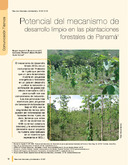Potencial del mecanismo de desarrollo limpio en las plantaciones forestales en Panamá
Alternative title
Potential of the clean development mechanism in forest plantations of Panama
Description
1 ilustración, 2 tabulación, 17 referencias, 7 páginas.
Abstract
Se determinó el potencial para proyectos de plantación forestal bajo el mecanismo de desarrollo limpio (MDL) en Panamá con un enfoque espacial. Se consideró la especie teca como representativa de las plantaciones forestales de Panamá.Se estudiaron la adicionalidad y la elegibilidad de tierras para ubicar las áreas de Panamá con más potencial. El análisis financiero de la adicionalidad está compuesto por dos elementos: la no rentabilidad sin el MDL y la rentabilidad con el MDL, y éstos dependen de la calidad de sitio, la distancia al puerto de referencia y del valor de la tierra. Se concluyó que las áreas con mayor potencial, teniendo en cuenta la adicionalidad y legibilidad de tierras, se encuentran en las regiones de Veraguas (36%), Panamá (28%), Darién (12%) y Herrera (9%). We determined the potentiality of the Clean Development Mechanism (CDM) for forest plantation projects in Panama. Additionality and land eligibility are the two most restrictive issues for afforestation/reforestation projects under the CDM. The potentiality of the CDM is composed of two factors: a low profitability without the CDM and a high profitability with the CDM, both depending on soil quality, distance to exportation port, and land value. Results showed that areas with greater potential of additionality and land eligibility were located in the regions of Veraguas (36%), Panama (28%), Herrera (9%) and Darien (12%). We determined the potentiality of the Clean Development
Mechanism (CDM) for forest plantation projects in
Panama. Additionality and land eligibility are the two
most restrictive issues for afforestation/reforestation
projects under the CDM. Additionality and land
eligibility were evaluated with a spatial approach to
locate the areas with more potentiality in Panama.
The potentiality of the CDM is composed of two
factors: a low profitability without the CDM and a
high profitability with the CDM, both depending
on soil quality, distance to exportation port, and
land value. A financial analysis was applied with
a general equation representing the profit value of
the plantations by districts. This equation used the
Land Expected Value (LEV) as financial indicator
and compared the LEV with the market land value,
assumed to be a proxy of the LEV for the best land
use if land speculation is not considered. Fuzzy
variables were used to represent the variability and
ambiguity of the parameters and their values. Teak
was selected as the representative species for
forest plantations in Panama. Results showed that
areas with greater potential of additionality and land
eligibility were located in the regions of Veraguas
(36%), Panama (28%), Herrera (9%) and Darien
(12%)
Keywords
Publisher
CATIE, Turrialba (Costa Rica) CATIE, Turrialba (Costa Rica)
URI (Permanet link to cite or share this item)
https://repositorio.catie.ac.cr/handle/11554/6686471959



